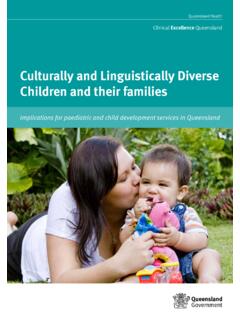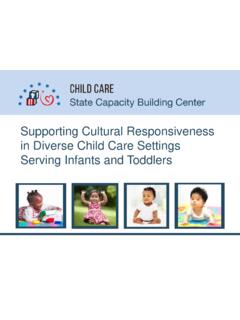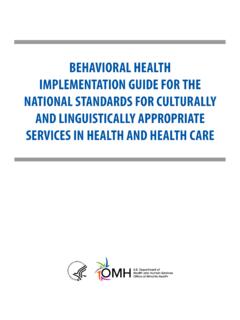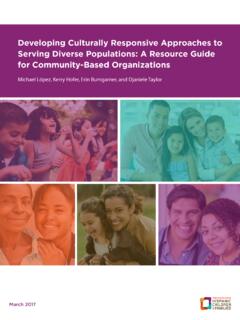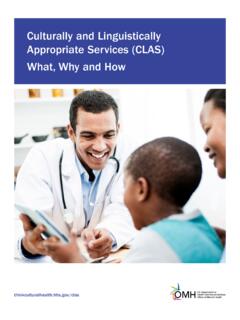Transcription of National Standards for Culturally and Linguistically ...
1 National Standards for Culturally and Linguistically appropriate Services in Health Care FINAL REPORT Department of Health and Human Services, OPHS O ffice of Minority Health March 2001 Washington, National Standards for Culturally and Linguistically appropriate Services in Health Care FINAL REPORT Department of Health and Human Services Office of Minority Health March 2001 Prepared by: IQ Solutions, Inc. 11300 Rockville Pike Suite 801 Rockville, MD 20852 Prepared for: Office of Minority Health Department of Health and Human Services Under Contract No. 282-99-0039 Table of Contents ACKNOWLEDGMENTS ..v PROJECT OVERVIEW ..1 National Standards FOR Culturally AND Linguistically appropriate SERVICES IN HEALTH CARE ..3 NARRATIVE OUTLINE ..21 PART I: BACKGROUND AND PURPOSE ..23 INTRODUCTION ..25 Recommendations ..36 PART II: INDIVIDUAL Standards WITH DISCUSSION.
2 45 INTRODUCTION ..47 Standard 1 ..49 Standard 2 ..54 Standard 3 ..59 Standard 4 ..65 Standard 5 ..70 Standard 6 ..72 Standard 7 ..77 Standard 8 ..83 Standard 9 ..88 Standard 10 ..92 Standard 11 ..98 Standard 12 ..102 Standard 13 ..106 Standard 14 ..109 PART III: METHODOLOGY AND ANALYSIS ..113 INTRODUCTION ..115 Development of the Draft CLAS Standards : Stage One ..115 Public Comment on and Revision of the CLAS Standards : Stage Two .. 116 National Project Advisory Committee ..117 PART IV: BIBLIOGRAPHY AND GLOSSARY ..121 BIBLIOGRAPHY ..123 GLOSSARY ..131 APPENDIX A National Advisory Council Member List ..A-3 Public Comment Regional Meetings Participants Lists San Francisco ..A-7 Baltimore ..A-17 Chicago ..A-33 Appendix B Source of Written Comments ..B-3 ACKNOWLEDGMENTS This report is the result of a multiyear process that involved countless numbers of special individuals across the United States and beyond.
3 We extend our appreciation to them: The National Project Advisory Committee (NPAC), for their dedication and tireless efforts in deliberating on countless drafts of the CLAS Standards and their provision of comments, opinions, and expertise during the many months of revisions. A complete list of NPAC members appears in Appendix A. The individuals and organizations whose written comments helped to shape the final CLAS Standards , and the hundreds of participants who attended the three regional meetings held as part of the public comment process. Information and feedback garnered at these sessions guided the development of the final version of the Standards . Rosters of all who wrote comments and attended the regional meetings appear in Appendix A. Dr. Nathan Stinson, Deputy Assistant Secretary for Minority Health, Department of Health and Human Services, for his ongoing support and commitment to the project.
4 Ms. Valerie Welsh, Evaluation Officer, Department of Health and Human Services, Office of Minority Health (OMH), who was instrumental in acquiring funding for the launching of the project. Mr. Guadalupe Pacheco of the Department of Health and Human Services Office of Minority Health (OMH) for his vision of conceiving the project and his substantive intellectual and personal contributions in his role as Project Officer. The core project staff for their indefatigable labor and efforts throughout the duration of this project: - C. Godfrey Jacobs of IQ Solutions, who served as Project Director. - Julia Puebla Fortier of Resources for Cross Cultural Health Care, who was Principal Investigator. - Gale Harris of IQ Solutions, who contributed as a Senior Writer. - Monica Barnhart of IQ Solutions, who served as a Senior Research Associate. - Michael Huddleston and Eileen Alexander of IQ Solutions, who served as Graphic Designers.
5 Office of Minority Health v PROJECT OVERVIEW As the population becomes more diverse, medical providers and other people involved in health care delivery are interacting with patients/consumers from many different cultural and linguistic backgrounds. Because culture and language are vital factors in how health care services are delivered and received, it is important that health care organizations and their staff understand and respond with sensitivity to the needs and preferences that Culturally and Linguistically diverse patients/consumers bring to the health encounter. Providing Culturally and Linguistically appropriate services (CLAS) to these patients has the potential to improve access to care, quality of care, and, ultimately, health outcomes. Unfortunately, a lack of comprehensive Standards has left organizations and providers with no clear guidance on how to provide CLAS in health care settings.
6 In 1997, the Office of Minority Health (OMH) undertook the development of National Standards to provide a much-needed alternative to the current patchwork of independently developed definitions, practices, and requirements concerning CLAS. The Office initiated a project to develop recommended National CLAS Standards that would support a more consistent and comprehensive approach to cultural and linguistic competence in health care. The first stage of the project involved a review and analysis of existing cultural and linguistic competence Standards and measures, the development of draft Standards , and revisions based on a review by a National advisory committee. The second stage focused on obtaining and incorporating input from organizations, agencies, and individuals that have a vital stake in the establishment of CLAS Standards . Publication of Standards in the Federal Register on December 15, 1999, announced a 4-month public comment period, which provided three regional meetings and a Web site as well as traditional avenues (mail and fax) for submitting feedback on the CLAS Standards .
7 A project team (consisting of staff members of OMH, its contractor, and subcontractor) analyzed public comments from 413 individuals or organizations and proposed revised Standards , with accompanying commentaries, to a National Project Advisory Committee (NPAC). Deliberations and additional review by NPAC members informed further refinements of the Standards . In their final version, the CLAS Standards reflect input from a broad range of stakeholders, including hospitals, community-based clinics, managed care organizations, home health agencies, and other types of health care organizations; physicians, nurses, and other providers; professional associations; State and Federal agencies and other policymakers; purchasers of health care; accreditation and credentialing agencies; educators; and patient advocates, advocacy groups, and consumers. The CLAS Standards were published in final form in the Federal Register on December 22, 2000, as recommended National Standards for adoption or adaptation by stakeholder organizations and agencies.
8 A preamble and the fourteen CLAS Standards follow. Office of Minority Health 1 Standards National Standards for Culturally and Linguistically appropriate Services in Health Care Preamble The following National Standards issued by the Department of Health and Human Services (HHS) Office of Minority Health (OMH) respond to the need to ensure that all people entering the health care system receive equitable and effective treatment in a Culturally and Linguistically appropriate manner. These Standards for Culturally and Linguistically appropriate services (CLAS) are proposed as a means to correct inequities that currently exist in the provision of health services and to make these services more responsive to the individual needs of all patients/consumers. The Standards are intended to be inclusive of all cultures and not limited to any particular population group or sets of groups; however, they are especially designed to address the needs of racial, ethnic, and linguistic population groups that experience unequal access to health services.
9 Ultimately, the aim of the Standards is to contribute to the elimination of racial and ethnic health disparities and to improve the health of all Americans. The CLAS Standards are primarily directed at health care organizations; however, individual providers are also encouraged to use the Standards to make their practices more Culturally and Linguistically accessible. The principles and activities of Culturally and Linguistically appropriate services should be integrated throughout an organization and undertaken in partnership with the communities being served. The 14 Standards are organized by themes: Culturally Competent Care ( Standards 1-3), Language Access Services ( Standards 4-7), and Organizational Supports for Cultural Competence ( Standards 8-14). Within this framework, there are three types of Standards of varying stringency: mandates, guidelines, and recommendations as follows: CLAS mandates are current Federal requirements for all recipients of Federal funds ( Standards 4, 5, 6, and 7).
10 CLAS guidelinesare activities recommended by OMH for adoption as mandates by Federal, State, and National accrediting agencies ( Standards 1, 2, 3, 8, 9, 10, 11, 12, and 13). CLAS recommendationsare suggested by OMH for voluntary adoption by health care organizations (Standard 14). The Standards are also intended for use by: Policymakers, to draft consistent and comprehensive laws, regulations, and contract language. This audience would include Federal, State and local legislators, administrative and oversight staff, and program managers. Accreditation and credentialing agencies, to assess and compare providers who say they offer Culturally competent services and to assure quality for diverse populations. This audience would include the Joint Commission on Accreditation of Healthcare Organizations, the National Committee for Quality Assurance, professional organizations such as the American Medical Association and American Nurses Association, and quality review organizations such as peer review organizations.


